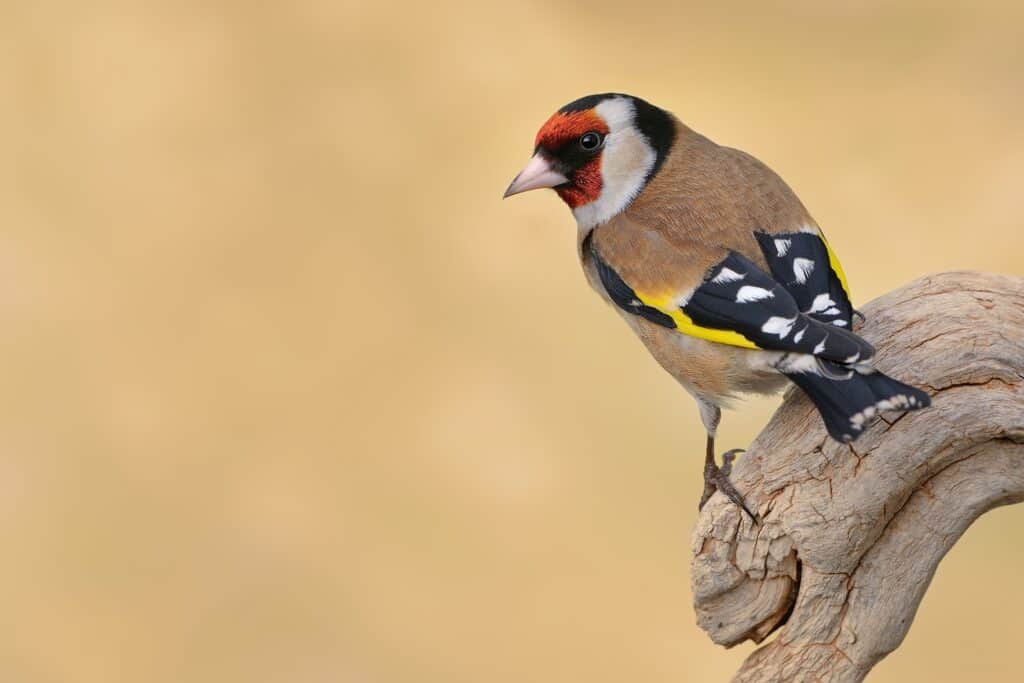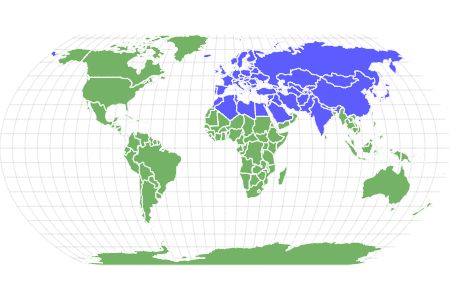European Goldfinch
Carduelis carduelis
They are frequent visitors to backyard feeders, especially those containing niger seeds.
Advertisement
European Goldfinch Scientific Classification
- Kingdom
- Animalia
- Phylum
- Chordata
- Class
- Aves
- Order
- Passeriformes
- Family
- Fringillidae
- Genus
- Carduelis
- Scientific Name
- Carduelis carduelis
Read our Complete Guide to Classification of Animals.
European Goldfinch Conservation Status
European Goldfinch Facts
- Prey
- Seeds, buds, flowers, and fruits
- Main Prey
- Small seeds
- Name Of Young
- Chicks
- Group Behavior
- Social
- Fun Fact
- They are frequent visitors to backyard feeders, especially those containing niger seeds.
- Estimated Population Size
- 55 to 88 million
- Biggest Threat
- Hunting and trapping
- Most Distinctive Feature
- Red face masks
- Distinctive Feature
- Black and yellow wings
- Wingspan
- 8.3 to 9.8 inches
- Incubation Period
- 11 to 13 days
- Age Of Fledgling
- 13 to 18 days
- Habitat
- Woodlands, farmlands, forest edges
- Diet
- Herbivore
- Lifestyle
- Diurnal
- Type
- Bird
- Common Name
- European goldfinch
- Number Of Species
- 14
- Location
- Europe, Africa, Asia
- Nesting Location
- Trees concealed with leaves
- Migratory
- 1
View all of the European Goldfinch images!
“The European goldfinch is a popular caged bird and is often illegally trafficked internationally.”
Summary
The European goldfinch (Carduelis carduelis) is native to Europe, Northern Africa, and Western to Central Asia. They inhabit open areas like woodlands and farmlands and spend all day covering an extensive area in search of food. They are social creatures, roosting and migrating in large flocks, and communicate with one another through tinkling melodies. Discover the exciting facts about the European goldfinch, including where it lives, what it eats, and how it behaves.
5 Amazing European Goldfinch Facts
- The European goldfinch is illegally trafficked and can be found in countries worldwide, including the United States.
- They attach their nests to tree twigs using spider silk.
- Males and females look similar, but males have slightly larger red face masks that extend to their eyes.
- They are frequent visitors to backyard feeders, especially those containing niger seeds.
- They forage by hovering over plants and will occasionally feed upside down.
Where to Find the European Goldfinch
European goldfinches live in Europe, Africa, and Asia in over 40 countries, including the United Kingdom, Russia, Germany, Armenia, and Turkey. They inhabit most of Europe but only reside in parts of North Africa and Western and Central Asia. Many populations are residents in their habitats, but those who live in colder regions may move south during winter. This bird is illegally trafficked and may appear in countries worldwide, including the United States, Canada, Mexico, Australia, and parts of South America. Their habitats include open to semi-open areas, such as woodlands, forest edges, farmlands, thickets, and roadsides.
European Goldfinch Nest
Females build the nest with mosses, lichens, and plant down, placing it several feet above the ground in a tree. She conceals her nest with leaves and attaches it to the tree using spider silk. The males don’t assist in the construction but accompany the females while they busily work.
Scientific Name
The European goldfinch (Carduelis carduelis) belongs to the Passeriformes order in the Fringillidae family, consisting of the true finches. The Carduelis genus encompasses three European finch species and is Latin for “goldfinch.”
There are 14 subspecies of the European goldfinch:
- C. c. balcanica: Southeastern European
- C. c. brevirostris: Crimea, the northern Caucasus
- C. c. britannica: the British Isles
- C. c. carduelis: most of the European mainland, Scandinavia
- C. c. colchica: Crimea and the northern Caucasus
- C. c. frigoris: Western Siberia
- C. c. niediecki: Southwest Asia
- C. c. parva: Canary Islands, Iberia, northwest Africa
- C. c. tschusii: Corsica, Sardinia, Sicily
- C. c. volgensis: Southern Ukraine, southwestern Russia, and Northwestern Kazakhstan
- C. c. caniceps: Southern Central Asia
- C. c. paropanisi: Afghanistan to the western Himalayas
- C. c. subulata: South-central Siberia to Lake Baikal and Northwest Mongolia
- C. c. ultima: Southern Iran
Size, Appearance, and Behavior
The European goldfinch is a small passerine bird, measuring 4.7 to 5.1 inches long and weighing 0.4 to 0.7 ounces, with an 8.3- to 9.8-inch wingspan. Males and females look similar, with red face masks and black and white heads. However, males have larger face masks that extend behind their eyes. This species also have brown bodies with white underparts and black and yellow wings.
These goldfinches are social birds, forming monogamous pairs during breeding and flocks of up to 40 individuals during winter. They communicate with each other through melodic songs. Their calls are tinkling trills and twitters, which sound like “teLLIT-teLLIT-teLLIT.” Goldfinches are diurnal, and this species spends its day covering an extensive range in search of food. At night, they roost in groups in trees or bushes.

The European goldfinch measures from 4.7-5.1 inches and weighs 0.4-0.7 ounces.
©Martin Pelanek/Shutterstock.com
Migration Pattern and Timing
The European goldfinches stay year-round in temperate regions but migrate from colder areas during winter. Most populations remain all year in the UK, but some groups may migrate as far south as Spain.
Diet
The European goldfinch is primarily an herbivore and typically only eats insects when young.
What Does the European Goldfinch Eat?
Their diet mainly consists of small seeds from thistles, cornflowers, and teasels. However, they will also eat buds, flowers, and fruits. It’s a frequent visitor to backyard bird feeders, especially those containing niger seed. These birds forage on the ground, in trees, shrubs, and weeds, quietly eating once they pick their fill. They often hover from plant to plant and may feed upside down.
Predators, Threats, and Conservation Status
The IUCN lists the European goldfinch as LC or “least concern.” Due to its extensive range and vast, increasing population, this species does not meet the criteria for “threatened” status. The biggest threat to this species is hunting and trapping. Moreover, it is a popular caged bird and is often illegally trafficked internationally.
What Eats the European Goldfinch?
Sparrowhawks and domestic cats are the primary predators of the European goldfinch, especially in the UK. Their nests are preyed on by various animals, such as mammals, snakes, and larger birds. Both parents defend a small area around their nests, and males will perch nearby and keep watch for intruders, giving alert calls when threatened.
Reproduction, Young, and Molting
European goldfinches form monogamous pair bonds for at least one breeding season, which begins in the spring. Females lay four to six white eggs with reddish-brown specks. The males bring food while the females incubate the eggs for 11 to 13 days. Both parents feed the chicks (seeds and insects), and they fledge the nest 13 to 18 days after hatching. Both sexes will continue to provide for their young for another week before preparing for their next brood (two to three a year). This species reaches sexual maturity around one year and lives an average of 2.4 years but can live up to 13 years.
Population
The global European goldfinch population is approximately 55 to 88 million mature individuals. Trends suggest the European population is increasing and stable everywhere else. They are not experiencing any extreme fluctuations or fragmentations in their numbers.
Related Animals:
View all 117 animals that start with EEuropean Goldfinch FAQs (Frequently Asked Questions)
Are there European goldfinches in the US?
European goldfinches are introduced to the US, but people mainly keep them as caged birds. If you see one in the wild, it most likely escaped.
Is the European goldfinch rare?
This species has a very large population and common in its range, often found near farms, roads, and abandoned buildings.
Where are European goldfinches found?
European goldfinches live in Europe, Africa, and Asia in over 40 countries. Their habitats include open to semi-open areas, such as woodlands, forest edges, and farmlands.
What do European goldfinch eat?
Their diet mainly consists of small seeds from thistles, cornflowers, and teasels. But they will also eat buds, flowers, and fruits.
How big are European goldfinch?
The European goldfinch is a small passerine bird, measuring 4.7 to 5.1 inches long and weighing 0.4 to 0.7 ounces, with an 8.3 to 9.8-inch wingspan.
Do European goldfinch migrate?
The European goldfinches stay year-round in temperate regions but migrate from colder areas during winter.
What threatens the European goldfinch?
The biggest threat to this species is hunting and trapping. It is a popular caged bird and is often illegally trafficked internationally.
Thank you for reading! Have some feedback for us? Contact the AZ Animals editorial team.
Sources
- IUCN Redlist of threatened species, Available here: https://www.iucnredlist.org/species/103764950/199579742
- CSIRO.au, Available here: https://www.publish.csiro.au/MU/MU970012

















